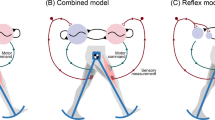Abstract.
Behavioral data concerning animal and human gaits and gait transitions are simulated as emergent properties of a central pattern generator (CPG) model. The CPG model is a version of the Ellias-Grossberg oscillator. Its neurons obey Hodgkin-Huxley type equations whose excitatory signals operate on a faster time scale than their inhibitory signals in a recurrent on-center off-surround anatomy. A descending command or GO signal activates the gaits and triggers gait transitions as its amplitude increases. A single model CPG can generate both in-phase and anti-phase oscillations at different GO amplitudes. Phase transitions from either in-phase to anti-phase oscillations or from anti-phase to in-phase oscillations can occur in different parameter ranges, as the GO signal increases. Quadruped vertebrate gaits, including the amble, the walk, all three pairwise gaits (trot, pace, and gallop), and the pronk are simulated using this property. Rapid gait transitions are simulated in the order – walk, trot, pace, and gallop – that occurs in the cat, along with the observed increase in oscillation frequency. Precise control of quadruped gait switching uses GO-dependent modulation of inhibitory interactions, which generates a different functional anatomy at different arousal levels. The primary human gaits (the walk and the run) and elephant gaits (the amble and the walk) are simulated, without modulation, by oscillations with the same phase relationships but different waveform shapes at different GO signal levels, much as the duty cycles of the feet are longer in the walk than in the run. Relevant neural data from spinal cord, globus pallidus, and motor cortex, among other structures, are discussed.
Similar content being viewed by others
Author information
Authors and Affiliations
Additional information
Received: 22 August 1994 / Accepted in revised form: 13 May 1997
Rights and permissions
About this article
Cite this article
Pribe, C., Grossberg, S. & Cohen, M. Neural control of interlimb oscillations . Biol Cybern 77, 141–152 (1997). https://doi.org/10.1007/s004220050375
Issue Date:
DOI: https://doi.org/10.1007/s004220050375



